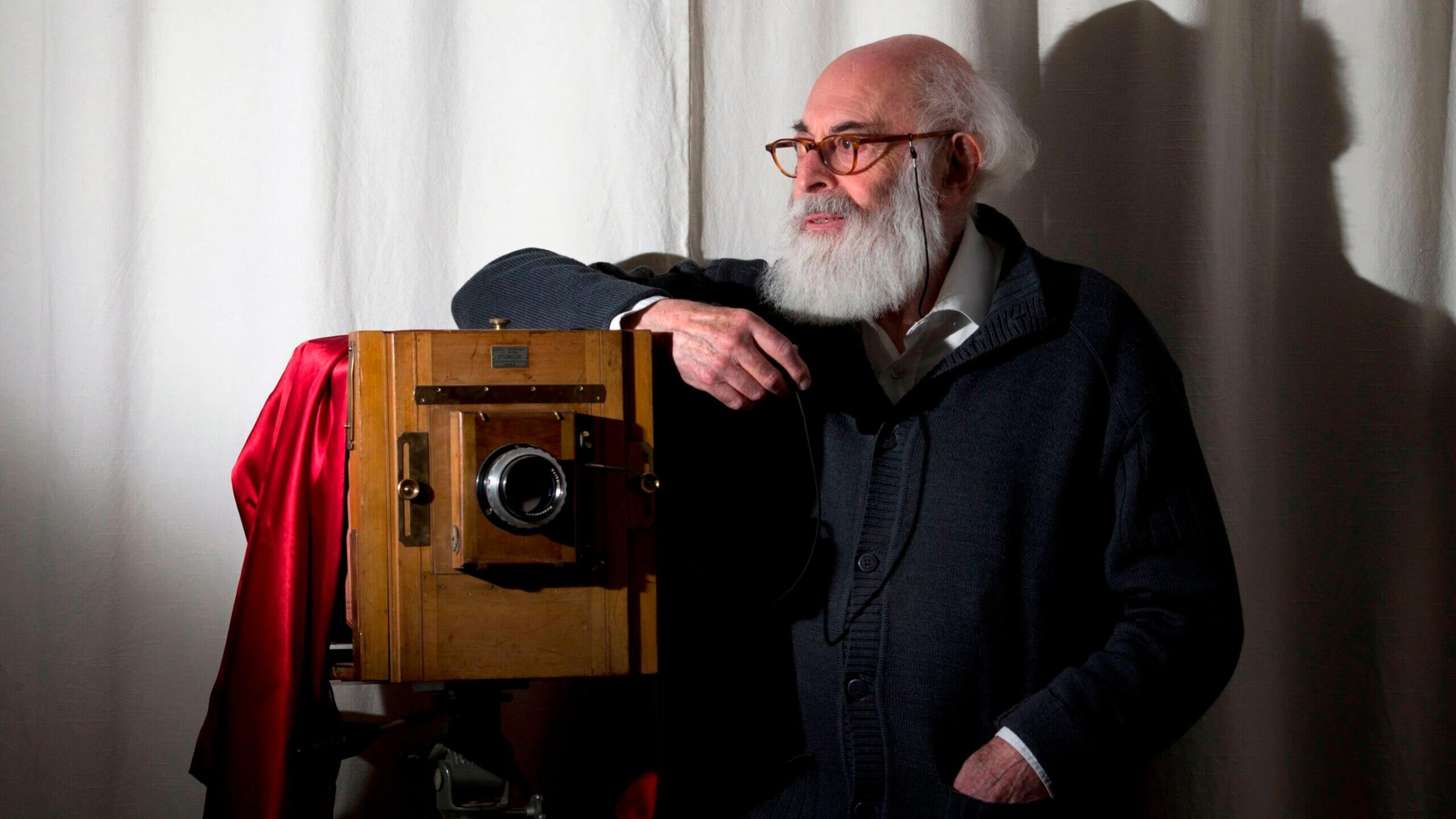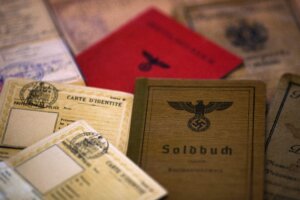How a master forger used his talents to save Jews, and many more
Adolfo Kaminsky created documents for freedom fighters and rebels around the world

Adolfo Kaminsky at home in Paris, 2012. Photo by Getty Images
Adolfo Kaminsky, who died Jan. 9 at age 97, was more than a French Resistance fighter who forged identity documents to help Jewish refugees during the Second World War. Born in Argentina of Russian Jewish origin, he was also a photographer of crystalline talent, as a 2019 exhibit at Paris’ Museum of the Art and History of Judaism (MAHJ) proved.
Images by Kaminsky ranged from glossy Studio Harcourt portraits of the French upper crust to humble prostitutes, street musicians and flea market vendors in postwar Paris. His style was somewhere between the sharply focused realism of Roman Vishniac, the Russian-born photographer of prewar Jewish ghettos, and the impressionistic nightlife images of the Hungarian Brassaï. In 1948, Kaminsky also created a self-portrait seated in the Fontainebleau Forest with something of the exalted facial expression of the poet Allen Ginsberg.
Faking documents
As elegiac as Kaminsky’s inspiration was, his abilities in counterfeiting wartime passports, ration cards and other essential items originated in humdrum daily work as a teenage dry cleaner’s assistant. While interning at a dairy in France, he learned that lactic acid dissolves Waterman brand blue ink. This would later help repurpose genuine documents to add new names.
In a technologically simpler era, when handwritten identity cards were common, so-called “fake-real” documents were an essential step for survival. Neatly removing an inked impression that branded a document holder as a Jew might mean the difference between escape or deportation to probable death. Similarly, faked ration cards sustained those fleeing the enemy.
Kaminsky was certainly not the only forger active in Occupied France. The biography A Good Place to Hide tells how in Southern France, Oscar Rosowsky, a teenage printer’s assistant of Russian Jewish origin, forged documents in wartime, braving all dangers. As his biographer put it, Rosowsky was a “mischievous man who enjoyed what he did and loved getting away with it.”
All such kvelling resistants were aware of the risks involved. At 18, Kaminsky toiled in a secret laboratory run by Maurice Loebenberg, a Swiss Jewish document forger who would be tortured to death by the French Gestapo in July 1944.
Alfred Sabatier (1907-1945), still another document forger, would be murdered in Siegburg Prison in the German state of North Rhine-Westphalia, a way station for Jewish deportees soon to be sent to Nazi extermination camps.

Postwar activism
Apart from sharing bravado with these less fortunate colleagues, Kaminsky was uniquely distinguished by his postwar career, during which he continued to produce false papers for all sorts of anti-establishment groups, some of them violent.
From 1946 to 1948, his skills were solicited to facilitate Jewish emigration to British Mandate Palestine. Even after the war, Jewish concentration camp survivors from Central and Eastern Europe were not officially permitted by the Soviet Union to leave their homelands, and the British stringently limited Jewish immigration.
To remedy these and similar situations, an underground so-called Bricha (escape in Hebrew) movement was formed. Not limiting himself to aiding Jewish emigration, Kaminsky also created convincing false documents for anti-British militants of the Irgun and Lehi paramilitary organizations.
In this way, perhaps inadvertently, he facilitated terrorist operations like the 1946 Irgun attack on the King David Hotel in Jerusalem that killed 91 people, among them Jewish and Arab soldiers and civilians, as well as the intended British targets.
After the foundation of the State of Israel in 1948, Kaminsky suddenly desisted from forging further documents. He claimed to oppose the notion of a religious state where rabbis had political power.
By that time, he was already employed by the French Army’s military intelligence unit, from which he eventually resigned to protest the First Indochina War waged to preserve French colonial interests in Southeast Asia.
Helping freedom fighters
Instead, Kaminsky labored for the National Liberation Front of Algeria, whose armed wing, the National Liberation Army, included guerilla units. In this struggle Kaminsky collaborated during the Algerian War with the Egyptian-born Jewish activist Henri Curiel, of Italian Sephardic origin.
Curiel would later be accused of running a “terrorist support network,” and a 1981 CIA report alleged that Curiel’s organization supported a “wide variety of Third World leftist revolutionary organizations,” including with “false documents, financial aid, and safe haven before and after operations, as well as some illegal training in France in weapons and explosives.” These accusations were registered posthumously; in 1978, Curiel was murdered execution-style in front of his Paris home, in a still-unsolved case.
Expanding his personal mission that was initially focused on saving Jews, Kaminsky proceeded to forge documents for freedom fighters and rebels from across Latin America, Africa, Portugal, Spain, Greece and anywhere else oppressive dictatorships had inspired resistance movements.
Among the 1960s revolutionaries he assisted was Daniel Cohn-Bendit, a French-German agitator of Jewish descent and later a politician. At the time when Kaminsky provided Cohn-Bendit with false papers, the latter was a student leader during the May 1968 protests in France.
Kaminsky officially stopped forging in 1971, doubtless considering himself fortunate to have survived as long as he did in a perilous occupation. This decision was purportedly made after he was asked to produce documents for anti-apartheid South African combatants. Ever-wary, Kaminsky suspected that the request might be a prelude to entrapment.
Instead, for a decade he relocated to Algeria, where he married the daughter of an imam from the Tuareg ethnic group. He subsequently raised a family, supporting them as a photography instructor.
A daughter tells the story
Apart from his longevity, among the main reasons for Kaminsky’s celebrity in recent years is that his daughter Sarah published a family memoir in 2009 that was translated into English in 2016. Among its claims was that the only time Kaminsky charged for forgeries was during the war, so he could afford to do it full time.
Also a screenwriter and actress, Sarah Kaminsky wrote the screenplay for the well-received 2021 film Farewell, Mr. Haffmann, about ordeals faced by common citizens during the Nazi Occupation of France.
And Kaminsky’s son, José Youcef Lamine Kaminsky, who performs as a rap musician under the stage name Rocé, shares a concern for activism as part of his heritage. In 2018, Rocé released an historic CD compilation of French protest songs expressing social agitation from the 1960s to the 1980s.
Kaminsky’s offspring have been notably more vocal than the retired forger himself was until recently. Kaminsky, for all his experience with fictional documents, carefully obtained a residence permit when he relocated his family to France in 1982, after which they were naturalized according to immigration law in 1992.
During a joint appearance in 2019 at the MAHJ, Sarah Kaminsky revealed that when she first announced plans to write about her father’s activism, his first reaction was to inquire about the “statute of limitations” for his deeds.
Today, a patina of nostalgia might envelop such actions, insofar as forging official documents has become increasingly difficult, and immigration law enforcement more inexorable in the computer age. Ultimately, the legacy of Adolfo Kaminsky is that determination to save Jews can expand to a wider conviction that other persecuted populations likewise deserve an opportunity to survive.
A message from our Publisher & CEO Rachel Fishman Feddersen

I hope you appreciated this article. Before you go, I’d like to ask you to please support the Forward’s award-winning, nonprofit journalism so that we can be prepared for whatever news 2025 brings.
At a time when other newsrooms are closing or cutting back, the Forward has removed its paywall and invested additional resources to report on the ground from Israel and around the U.S. on the impact of the war, rising antisemitism and polarized discourse.
Readers like you make it all possible. Support our work by becoming a Forward Member and connect with our journalism and your community.
— Rachel Fishman Feddersen, Publisher and CEO






























